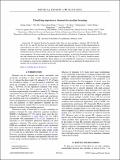Classifying superheavy elements by machine learning
Author(s)
Gong, Sheng; Wu, Wei; Wang, Fancy Qian; Liu, Jie; Zhao, Yu; Shen, Yiheng; Wang, Shuo; Sun, Qiang; Wang, Qian; ... Show more Show less
DownloadPhysRevA.99.022110.pdf (1.854Mb)
PUBLISHER_POLICY
Publisher Policy
Article is made available in accordance with the publisher's policy and may be subject to US copyright law. Please refer to the publisher's site for terms of use.
Terms of use
Metadata
Show full item recordAbstract
Among the 118 elements listed in the periodic table, there are nine superheavy elements (Mt, Ds, Mc, Rg, Nh, Fl, Lv, Ts, and Og) that have not yet been well studied experimentally because of their limited half-lives and production rates. How to classify these elements for further study remains an open question. For superheavy elements, although relativistic quantum-mechanical calculations for the single atoms are more accurate and reliable than those for their molecules and crystals, there is no study reported to classify elements solely based on atomic properties. By using cutting-edge machine learning techniques, we find the relationship between atomic data and classification of elements, and further identify that Mt, Ds, Mc, Rg, Lv, Ts, and Og should be metals, while Nh and Fl should be metalloids. These findings not only highlight the significance of machine learning for superheavy atoms but also challenge the conventional belief that one can determine the characteristics of an element only by looking at its position in the table.
Date issued
2019-02Department
Massachusetts Institute of Technology. Department of Materials Science and EngineeringJournal
Physical Review A
Publisher
American Physical Society
Citation
Gong, Sheng et al. "Classifying superheavy elements by machine learning." Physical Review A 99, 2 (February 2019): 022110 © 2019 American Physical Society
Version: Final published version
ISSN
2469-9926
2469-9934